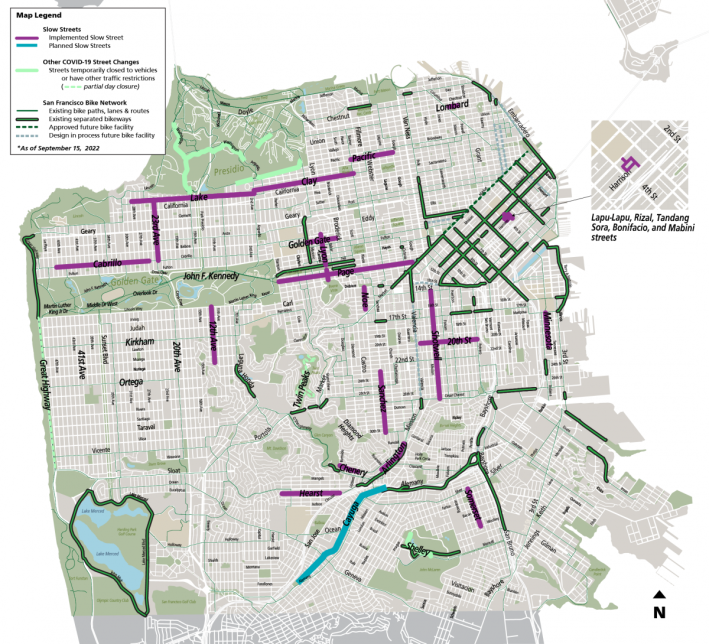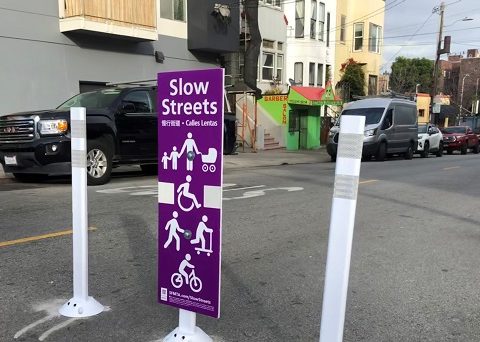URGENT: Express support for making the Slow Streets program permanent. Endorse the People’s Slow Streets plan. The SFMTA board will vote sometime during their meeting Tuesday/tomorrow, December 6, starting at 3 p.m. on the program.
The SFMTA Board will vote Tuesday/tomorrow, Dec. 6, on the future of the Slow Streets program. In November, an overwhelming majority of voters made it clear through the passage of Prop. J and the defeat of Prop. I that they want more slow and safe streets and they want an end to the near-total use of the asphalt between buildings for motorized traffic. Nevertheless, some vocal motorists remain opposed to the Slow Streets program, and it is in danger of getting rolled back. And for anyone who doubts that's the case:
Barriers are being removed from @SlowLakeStreet this morning. People are upset and confused because the @SFMTA_Muni Board has not yet made a decision. All the more reason it is so CRITICAL to show up and speak up tomorrow at the meeting! Please sign up and show up! https://t.co/udoDDMbj71
— Ruth Malone PhD @RMalone@sfbasocial BollardGranny (@MaloneRuth) December 5, 2022
From an editorial in the San Francisco Chronicle in support of continuing the program:
Of the more than 15,000 San Franciscans polled by the agency in the first year of the Slow Streets, 69% reported having a very positive reaction to them. SFMTA Director of Transportation Jeffrey Tumlin said last year that Slow Streets has been the agency’s “most popular COVID experiment.”
On Tuesday, the agency will review whether to make fifteen of these Slow Streets permanent. It’s already voted on a few before: Last year the agency’s board approved Lake, Golden Gate, Sanchez and Shotwell streets. Now all except Lake Street are up for a vote again, in addition to thirteen other streets: 12th Avenue, 22nd Street, 23rd Avenue, Arlington Street, Cabrillo Street, Cayuga Avenue, Clay Street, Hearst Avenue, Lyon Street, Minnesota Street, Shotwell Street and Somerset Street. The reason some streets are being reconsidered: the passage of AB 773, a statewide bill that permits slow street programs, has changed how they can be designated. This vote would place them under a new designation, protecting them more permanently for years to come.
However, the COVID "experiment" is set to expire in a few months if the directors don't vote to extend it. Readers may note that Oakland, which pioneered the idea, abandoned its Slow Streets program in February. The same thing could happen in San Francisco.

Advocates have set up a page to help readers call in and make their wishes known during the meeting. Advocates also want the city to make good on a promised Slow Streets network - to facilitate not only neighborhood spaces, but to create connected slow streets that provide safe paths for cycling across the entire city. "There's excellent precedent in Portland's Greenways for what it would take to connect the network, and it would be nice to see this aspect of the Slow Streets discussion getting some attention," wrote advocate Luke Spray in an email to Streetsblog. Read more about that on the People's Slow Streets Fact Sheet or check out their vision map.
Email the SFMTA board. And attend the meeting, Tuesday, December 6, at 3 p.m. City Hall, 1 Dr. Carlton B. Goodlett Place, San Francisco, CA, Room 400, Floor 4. Or join online (sfgovtv.org/sfmtaLIVE).





